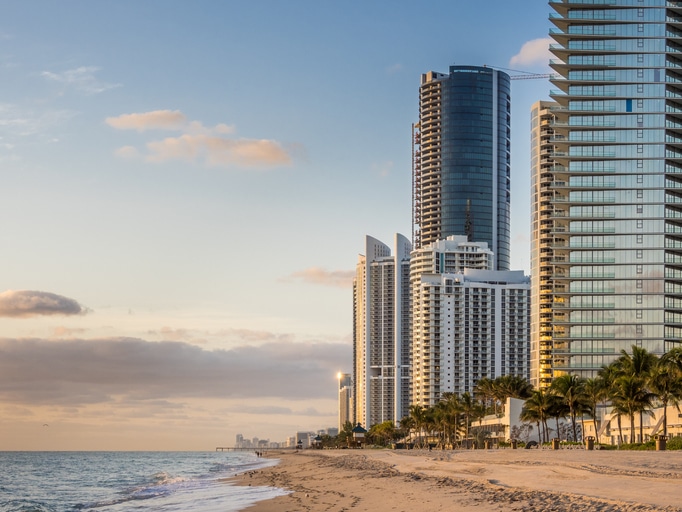Source: Miami Herald —
Miami isn’t known for its majestic mountains. The tallest peaks in the South Florida landscape, in fact, are a series of landfills. The highest point south of Lake Okeechobee is the dump at Monarch Hill Renewable Energy Park, better known as Mount Trashmore, which towers 225 smelly feet above northern Broward County.
But there are natural bumps and ridges of limestone that gradually rise and fall along the length of South Florida. In Miami-Dade County, the tallest of these slopes soar to the dizzying height of about 20 feet above sea level. At these alpine altitudes, you’ll find strange things not seen anywhere else in Miami: mountain biking trails, underground cave systems, even houses with basements.
The highest points in Miami-Dade County are unmarked and largely unnoticed. But high ground has played an outsized role in the history of South Florida’s development — and, more importantly, offers clues about how climate change could shape the region’s future. Starting with its real estate market.
The scientists who study South Florida’s limestone ridges say there’s a warning hidden in the rock beneath our feet. All of it formed underwater, at a time when South Florida was at the bottom of a shallow sea. Now, sea levels are rising. One day — it’s hard to pinpoint when — even our highest ground may be underwater once again.
“Everybody thinks this is a God-given sea level,” said Harold Wanless, who heads the University of Miami’s geology department. “There’s nothing special about where the sea level is right now.”
As the tides inch higher and flooding becomes more common, more developers and home buyers are starting to seek out land at higher elevations. The past also provides a lesson there: High ground has long been some of the most desirable real estate in Miami.
That’s why Miami-Dade County’s highest ground is home to the oldest houses in Miami and some of the earliest evidence of human settlement south of Lake Okeechobee. “High ground is essentially where settlers were forced to live until the Everglades began to be drained in the early 1900s,” said Paul George, resident historian at HistoryMiami.
But as housing prices rise, some community groups are warning about the risk of climate gentrification, a process that pushes out poor residents living in higher and drier neighborhoods to make way for wealthier renters and buyers who want a home that’s safe from flooding.
“The climate-driven component of gentrification is creating a situation where it’s raising the cost of living, it’s really squeezing people and it’s forcing them out,” said Paul Namphy, lead organizer and political director at the Family Action Network Movement (FANM), a community advocacy group based in Little Haiti.
HOMEOWNERS ON THE HIGH GROUND
Waterfront properties, despite being vulnerable to hurricanes and sea rise, are still some of the most desirable and expensive real estate in South Florida. But in recent years, buyers and renters have become more interested in high ground, and government agencies have given them more tools to research their homes’ elevation and flood risk.
Miami-Dade County publishes extremely detailed elevation data online. The data comes from lidar drones, which fly overhead bouncing laser beams off the ground to map the county’s topography. The Miami Herald consulted this data to identify the county’s highest points for this story.
Broward and Palm Beach counties don’t publish the same level of detailed data, but county records and research carried out by the county highpointers, a niche group of hobbyists who travel the U.S. climbing the highest points in every county, confirm that Broward’s natural highest point is 29 feet above sea level at Pine Island Ridge and Palm Beach’s highest point is about 50 feet above sea level somewhere in Jupiter, within the gated community of The Bluffs. Florida’s highest point is 345-foot Britton Hill in Walton County in the Florida Panhandle.
Potential home buyers and renters can also use the National Oceanic and Atmospheric Administration’s Sea Level Rise Viewer, a free tool that lets you see what parts of your neighborhood might flood — or sink beneath the water — under future climate change scenarios.
Reid Grier, the president of a senior care company called Right at Home, consulted NOAA’s Sea Level Rise Viewer when he bought a home near Coral Gables at one of the highest points in Miami-Dade County in November 2020.
As Grier raised the hypothetical sea levels by one foot, then two, then 10, he saw water surge in from the coasts and spill out of canals. But the water didn’t touch his future home, which is built 20 feet above sea level. “It essentially showed our block being one of the few remaining pieces of land above water,” Grier said.
Grier has family in Houston and he saw the destruction after Hurricane Harvey flooded the city in 2017. He didn’t want to buy a house that faced the same risk. “The fact that we are far enough away from the coast and outside of any flood risk area,” said Grier, “it just gives us peace of mind.”
A.J. Barranco, a lawyer who has lived at another one of the county’s highest points in Coconut Grove since 1978, learned just how valuable elevation can be during a major hurricane. Barranco’s house is perched on a limestone bluff overlooking South Bayshore Drive, which protected it when Hurricane Andrew struck in 1992 and created a storm surge along the coast of Biscayne Bay.
“The houses down below me were all flooded. There were sailboats on South Bayshore Drive,” Barranco recalls. His front lawn was strewn with debris — oars, life vests, sails, flippers and so on. But his house, built 22 feet above sea level, was untouched except for a little flooding in the basement. “I’ve always felt very fortunate being this high up,” he said.














